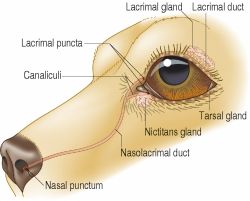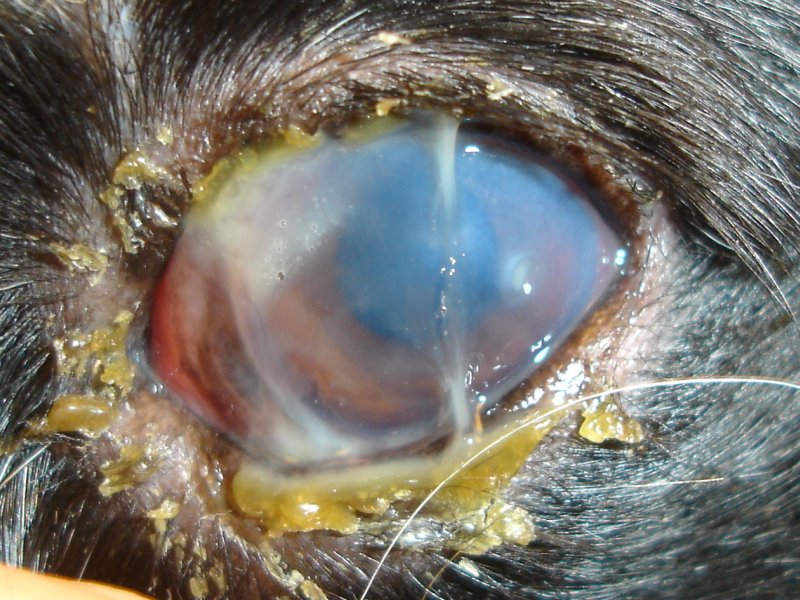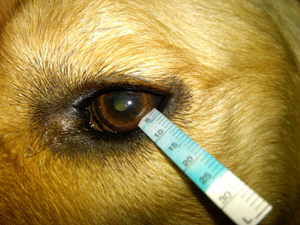The eyes of dogs are beautiful orbs with intricate parts functioning together to enable each of us to see the incredible world surrounding us. Their eyes, like ours, require constant lubrication. Without it, the conjunctiva (thin membrane of tissue covering the sclera / the “white” of the eye”) and cornea (clear part of the eye) become markedly inflamed. Subsequent ulceration and infection occur, potentially affecting vision. Keratoconjunctivitis, more commonly called dry eye, is a common ophthalmic disease dogs. This week I’ve dedicated some time to share information about this important condition. Happy reading!
Keratoconjunctivitis Sicca (KCS) – What causes it?
To fully understand keratoconjunctivitis sicca, one must have a basic understanding of the tear-producing system of the body. This system is called the lacrimal apparatus, and it has several unique components:
- Lacrimal and third-eyelid glands
- Accessory lacrimal glands
- Pre-corneal tear film
- Mucous threads
- Lacrimal puncta and canaliculi
- Nasolacrimal duct
- Nasal puncta

An abnormality in any of these components can lead to keratoconjunctivitis sicca. As this disease is so common in dogs (affecting ~1% of canine population), veterinarians have identified potential causes of KCS, including:
- Idiopathic – Idiopathic is the fancy medical way of saying “we don’t know why” and the majority of patients with KCS fall under the category.
- Drugs – Some medications, particularly those containing sulfa compounds, may result in KCS with long-term administration. The drug phenozopyridine typically induces KCS within 7-10 days.
- Surgical removal of the third eyelid and/or lacrimal glands
- Immune-mediated disease – The immune system may attack the cells within the lacrimal and third eyelid glands, resulting in marked inflammation and an inability to produce an adequate volume of tears.
- Trauma – Any accident that damages the lacrimal and third eyelid glands (or the nerves supplying these structures) could result in KCS.
- Distemper virus – This viral infection can temporarily or permanently damage the lacrimal and third eyelid glands.
- Radiation therapy – This cancer therapy can damage the lacrimal and third eyelid glands to result in reduced tear production.
- Congenital disorder – Pugs, Chihuahuas, and Yorkshire terriers may be born with under-developed tear-producing glands (congenital acinar hypoplasia).
Keratoconjunctivitis Sicca (KCS) – What does it look like?
The most common clinical signs associated with keratoconjunctivitis sicca are:
- Blepharospasm – Blepharospasm is the involuntary closure of the eyelid, and is the result of discomfort.
- Eye discharge – the fluid that continuously coats the cornea is called the pre-corneal tear film. This film has 3 components, each with a different composition. When the middle layer (called the aqueous layer) is deficient, a thick and stringy mucus accumulates. This mucus often sticks to the conjunctiva and cornea as ropy strands.

- Corneal erosions & ulcers
- Corneal pigmentation and new vessel formation – With chronic dryness, the cornea will grow new blood vessels and pigment will be deposited in this normally clear structure.
- Lusterless cornea – When the pre-corneal tear film is deficiency, the cornea loses its clear, moist, and brilliant appearance.
- Dry nostril(s) – The nostril on the side of the affected eye(s) often similarly becomes dry.
Some breeds are over-represented for developing keratoconjuncitivitis sicca, including:
- American cocker spaniel
- Bloodhound
- Boston terrier
- English springer spaniel
- Cavalier King Charles spaniel
- Lhasa Apso
- Pekingese
- Poodle
- Pug
- Samoyeds
- West Highland white terrier
- Yorkshire terrier
- English bulldog
- Miniature schnauzer
Keratoconjunctivitis Sicca (KCS) – How is it diagnosed?
The diagnosis of dry eye is relatively straightforward. Testing is indicated based on a patient’s history and physical examination findings. Veterinarians perform a non-invasive evaluation of a pet’s pre-corneal tear film called a Schirmer Tear Test (STT). To perform the test, a thin strip on special paper with a dye is gently hooked over the lower eyelid. The dye travels up the strip when moistened by the pre-corneal tear film.

Keratoconjunctivitis Sicca (KCS) – How it is treated?
The treatment of keratoconjunctivitis sicca may involve various medications, as well as potential surgeries. Most patients can be managed medically, but pet parents have to be willing and able to administer eye medications consistently. Medical management often has several components, including:
- Replacement of the pre-corneal tear film
- Stimulation of normal secretion of the pre-corneal tear film
- Control of secondary infection
- Removal of excess mucus
- Modulation of immune-mediated inflammation
Artificial tears (i.e.: GenTeal®) are lubricant eye drops often recommended by board-certified veterinary ophthalmologists to replace the pre-corneal tear film. Other medications, including cyclosporine (Optimmune®) or tacrolimus, are prescribed to stimulate tear production and suppress immune-mediated inflammation. An ophthalmic antibiotic may be needed if a patient develops a secondary bacterial infection. Similarly, a veterinarian may prescribe an ophthalmic drug called acetylcysteine to help remove excess mucus and further protect the cornea. Consultation with a board-certified veterinary ophthalmologist can be invaluable to ensure an affected patient is treated logically and appropriately in a cost-effective manner.
Some patients simply don’t respond to prescribed eye medications. Of course, some pet parents simply can’t administer the necessary eye medications. In these situations, a surgical procedure called a parotid duct transposition can be performed. The parotid duct carries saliva from the parotid salivary gland to the mouth. The duct can be relocated (transposed) so the end that would normally empties in the mouth actually terminates in the conjunctival sac provide lubrication. This surgery is quite intricate, and demands precision. Evaluation by a board-certified veterinary ophthalmologist is recommended before this surgery is performed.
The take-away message about keratoconjunctivitis Sicca (KCS) in dogs…
Keratoconjunctivitis sicca or dry eye is one of the most common eye disorders affecting dogs. Diagnosing KCS is relatively straightforward. Initial treatment commonly involves several eye medications. Unfortunately, some patients don’t respond to medical management, and these patients may undergo an intricate surgery to improve eye lubrication. Partnering with a board-certified veterinary ophthalmologist can be truly helpful to ensure accurate diagnosis and effective treatment.
To find a board-certified veterinary ophthalmologist, please visit the American College of Veterinary Ophthalmologists.
Wishing you wet-nosed kisses,
cgb






